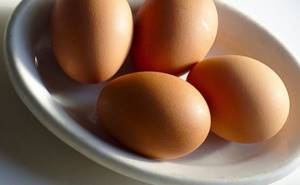A mixture of a couple of eggs, milk and sausage, called an omelet, is one of the easiest dishes to prepare. And most importantly, it gives free rein to your imagination, because you can vary the ingredients as you wish, not forgetting the egg-milk base. From a quick, express option to a gourmet dish, it can be truly varied. But sometimes you have to think about how many calories are in an omelet. After all, despite the fact that it seems healthy, the “weight” of a dish can be affected not only by its composition, but also by the method of preparation.
The benefits of omelet
When consumed in moderation, the benefits of omelet are quite large:
- the dish is rich in vitamins and minerals that strengthen the immune system;
- omelet is indicated for chronic muscle pain and headaches;
- the B vitamins contained in the omelet are beneficial for the health of the nervous system;
- the main component of the omelet is chicken eggs, which contain a lot of vitamins A, E, D;
- omelette vitamin A is a natural antioxidant that is beneficial for the health of bones, eyes, skin, as well as the regulation of protein synthesis during oxidative and reduction processes;
- omelet B vitamins are useful for maintaining muscle tone and accelerating metabolism;
- vitamin E in the product is necessary to increase the elasticity of blood vessels and rapid healing of wounds;
- Calcium and carbonate from egg dishes are used to stimulate bone marrow function.
How to cook an omelette
To prepare the dish you will need 3 chicken eggs, 35 g of butter, a quarter teaspoon of salt, a fifth of a teaspoon of ground pepper.
Cooking steps:
- Beat the eggs with a fork until the mixture becomes homogeneous. Be careful not to over-beat the eggs, which can cause the omelet to be too dense.
- Place 35 g of butter on a well-heated frying pan over medium heat. As soon as the butter melts, pour the previously obtained egg mixture onto it.
- Frying the omelet lasts 1.5 - 2 minutes. The indicator of readiness of the dish is a golden crust on the sides, slightly viscous in the middle.
- Remove the finished omelette from the heat, sprinkle with ground pepper and salt.
The dish goes well with rye bread and vegetables. Bon appetit!
The main ingredients for an omelet are traditional eggs and milk, and as for other products sometimes used, it depends on the preferences and tastes of the person for whom this dish is intended. The omelet cooks very quickly
, so it is often made for breakfast. But many people who care about their figure are interested in how much its use will affect it.
The average calorie content of 100 grams of omelet is 185 kcal.
It contains
:
- carbohydrates 2 g;
- proteins 11 g;
- fat 15 gr.
An omelet can be made from different quantities of eggs and milk of any fat content, so when calculating the individual energy value you need to know the base load:
In 100 gr. eggs contain 157 kcal, and the same amount of milk with a fat content of 3.2% is 59 kcal.
Based on this, you can determine the calorie content of the dish you prepare at home.
The calorie content of an omelet is, on average, 120 kcal per 100 grams of product
Its calorie content is determined by 10 grams. proteins, 16 gr. fat and only 2 gr. carbohydrates. Of course, this is an inaccurate result, since in addition to eggs, butter, milk and cheese, many other products that we talked about earlier are often added to the omelet.
What is the calorie content of an omelet prepared in different ways? And here it is:
Calorie table for omelet, per 100 grams of product:
And the nutritional value of an omelet prepared in different ways is this:
Table of nutritional value of omelet (BJU), per 100 grams of product:
| Product | Squirrels, gr. | Fats, gr. | Carbohydrates, gr. |
| omelette with milk | 8,5 | 7,6 | 2,5 |
| omelette with tomatoes | 5,7 | 6,6 | 3,6 |
| Omelet with cheese | 16,0 | 29,0 | 2,5 |
| omelette with mushrooms | 5,3 | 6,1 | 2,5 |
| omelet with ham | 11,2 | 15,2 | 4,0 |
| broccoli omelette | 6,0 | 7,0 | 6,0 |
| omelette with vegetables | 6,2 | 13,2 | 3,5 |
| egg white omelette | 8,6 | 3,4 | 1,7 |
How to prepare this dish at home? Very simple! Here is one of the recipes:
Omelette with tomatoes:
Products:
- Egg - 4 pieces
- Cheese – 150 gr.
- Butter - 2 tablespoons
- Tomatoes - 3-4 pieces
- Green onions and salt - to taste
Tomatoes are peeled by first pouring boiling water over them so that the skin comes off more easily. The pulp is cut into pieces and fried in a frying pan (in butter). Place the fried tomatoes on a plate. Beat the eggs (with salt), combine them with finely chopped onion and shredded cheese. Everything gets mixed up. Melt the remaining butter in a frying pan, place the tomatoes on it and then pour in the prepared egg mixture.
The dish is baked over low heat for about 5-8 minutes. When the omelette is ready, you can decorate it with chopped dill, parsley or green onions. And eat healthy! True, the calorie content of an omelet prepared according to this recipe is not so small. Therefore, eat, but in moderation.
Omelette of 2 eggs with milk and tomatoes
The calorie content of a simple omelet made from two eggs and milk, cooked with a minimum amount of butter, is 161 kcal.
The most popular variation of this dish involves adding tomatoes.
An omelette made with milk with two eggs and the addition of a tomato contains 151 kcal per 100 grams.
To reduce the energy value of the dish, you can use skim milk or use a few more techniques.
Calorie content and nutritional value of an omelet made from 2 eggs and milk
This food product is included in the diet of BZHU supporters as a convenient breakfast option, ready to give you a feeling of fullness for several hours.
The final nutritional value of a dish depends on a significant number of additional factors. Including:
- The size of the selected eggs. Small ones weigh about 30 grams, medium ones about 40 grams, large ones can reach a weight of 90 grams.
- Type of additional fillers, choice of milk of varying degrees of fat, cream.
- The choice of oil for frying or not using oil.
The dish, which was prepared from medium-sized eggs, from 40 to 50 grams, contains about 135 kcal per 100 grams.
Classic recipe
The simplest way to prepare this widespread and well-known dish is to use two medium-sized eggs, approximately 50 grams of medium-fat milk.
Break the eggs into a deep container and beat until thick foam appears with salt and spices. At the end of the beating, add milk and continue using the mixer or whisk. The finished mass should be knocked out into a preheated frying pan.
When cooking, both vegetable and butter can be used. The use of this component will significantly increase calorie content. It can increase to 230 kcal per 100 grams. When following healthy eating principles, it is recommended to use a non-stick frying pan or steam an omelet.
When calculating the BJU in the case of preparing the option in oil, the finished omelette will include:
- about 25.5 grams of fat, which is about 72% of the daily value
- about 19 grams of protein, which is approximately 24% of the norm for BJU proteins per day
- approximately 3.5 grams of carbohydrates, or about 4% of the daily value of BZHU
Good to know!
It is no coincidence that this dish is recognized as a healthy and tasty breakfast option. It brings a large amount of nutrients to the body, becoming a good food base for the whole day.
This product will be a good helper in losing weight. The components of the sweets have a gentle effect on the body, have a 100% natural composition, this determines the absence of side effects.
Of course, it is especially important to combine taking pills with proper nutrition and exercise. In this case, the effectiveness will be maximum, and the result will be noticeable on your face.
Other omelet recipes
The recipes for this delicious dish include a wide range of options, including a variety of additional ingredients. Such additions can significantly change overall caloric intake.
The list of additives that are not recommended for supporters of a healthy lifestyle and healthy lifestyle includes cheese, sausages, sausage, croutons made from white wheat bread, and lard. In this case, those who are not yet accustomed to the principles of healthy eating will have to remind themselves that everything “delicious” and “fatty” ultimately becomes harmful and contributes to weight gain.
Note!
It is useful to diversify the classic recipe using vegetable additives. For example, tomatoes or cauliflower will reduce your overall caloric intake. When using cauliflower, this figure will decrease from 230 to 135 kcal per 100 grams.
How to cook a low-calorie omelette?
Proponents of proper nutrition can pay attention to dish options with minimal calorie content:
- An omelette steamed only from whites without the use of yolks and milk will add only 70 kcal per 100 grams to the calorie table.
- An omelet with tomato added will only contain 98 kcal.
- If you use bell pepper, the figure will change and be 76 kcal.
- By adding mushrooms, you can get a dish with a nutritional value of 83 kcal.
- Including broccoli in the egg mixture will increase the figure to 104 kcal.
- You can add chicken breast to get up to 138 kcal per 100 g.
Note!
To reduce nutritional value, it is also recommended to use milk with a fat content of 2.5%. When planning to add cheese, you will need to give preference to low-fat varieties.
A dish made only from eggs with a small addition of low-fat milk can be called one of the most successful food options for weight loss supporters.
The benefits of eggs include the inclusion in the composition of a chicken egg:
- Vitamin A necessary for immunity, optimal condition of skin, hair and nails
- B vitamins that are beneficial for the immune system and nervous system.
- Vitamins of group D that promote natural vasodilation.
- Vitamin E, ready to heal wounds and strengthen the walls of blood vessels.
Good to know!
This product also contains a large number of microelements and nutrients. Including magnesium, sodium, folic acid, iron, iodine and other components. Lutein helps break down bad cholesterol.
Low calorie omelette
Such a dietary dish is quite possible if you prepare it correctly. First of all, it’s better not to fry an omelet
: fried blueberries contain carcinogens that have a negative effect on the liver. And they, like the fats contained in oil, lead to weight gain.
It is advisable to cook an omelet in a slow cooker or double boiler. It makes sense not to use the yolks:
One hundred grams of omelette with whites alone contains only 85 kcal.
Greens also reduce energy value: parsley, basil, dill help the digestive system and are excellent aids in the fight against fat deposits.
Even the most “crooked/lazy” man can cook omelet and fried eggs, because this process does not require any culinary talents. However, people struggling with excess weight should know how many calories are in a milk omelet with several eggs.
The most useful omelet recipes
After figuring out the calorie content of an omelet, people who follow a healthy diet will definitely want to know how to reduce it without sacrificing taste and quality. So, the first and most important thing is to stop frying. Yes, a crispy crust is wonderful, but it is also carcinogenic and can increase the load on the liver. Given that eggs are already the leader among other products with the last point, you shouldn’t tempt fate once again. It is better to give preference to an oven, multicooker or double boiler.
An elementary comparison: the calorie content of an omelet made from eggs, milk, onions, tomatoes and pork ham in a slow cooker will be 130 kcal per 100 g, while in a frying pan the same mixture will already “weigh” 198 kcal at best.
Second: it is worth adding greens to the omelet. Parsley, dill, basil - these small branches are excellent fighters against excess fat, and also work excellently to protect the health of the gastrointestinal tract. And you should choose not dried options, but fresh ones, if possible.
Third: the calorie content of an omelet made from eggs is higher than the calorie content of an omelet made from proteins alone. 130 kcal versus 85 kcal is still a noticeable difference. This is due to the fact that the heaviest and fattest part of the egg is the yolk. Moreover, by removing it, you can get a dish that is light in every sense: not only in terms of calorie content, but also in terms of its consistency. The omelette will turn out airy and tender if the whites are fresh, cold and form a strong foam.
Fourth: few people know that counting calories, an omelette can be prepared... using “table” mineral water. Yes, the taste will be somewhat peculiar, but this is a matter of habit. But such a magnificent option will not work in any other combination.
If we talk about the filling, then in addition to the ingredients themselves, which “set the tone” for the caloric content of the dish, it would not be amiss to remember about the method of their preparation. If vegetables can still be thrown raw, then, for example, this will not work with meat. It is advisable to choose chicken or turkey, boil it first, and then add it to the mixture. Otherwise, in terms of the number of calories, an omelet prepared with steamed pork will be comparable to an omelet with fried poultry added.
Even the most “crooked/lazy” man can cook omelet and fried eggs, because this process does not require any culinary talents. However, people struggling with excess weight should know how many calories are in a milk omelet with several eggs.
How many calories are in a 2 egg omelette with milk?
The calorie content of 100 grams of an omelet made from two eggs is 172 kcal. That is, the calorie content of an omelet made from two eggs increases by the energy value of one egg (approximately).
After such a simple conclusion, it is easy to answer the question: “How many calories are in an omelet of 3 eggs with milk?” - 216 kcal.
You can reduce the calories in this omelet recipe by replacing the milk with water. After all, the calorie content of an omelet with milk is much higher than that of a cooked product with water.
And then the admirer of chicken eggs will not ask the question that is framed in the subtitle, but only: “How many calories are in an omelet made from 2 eggs?”
Below we will look at ways to reduce the calorie content of an omelet made from 2 yolks and 3 whites of eggs with milk.
Calorie content of 2 egg omelet with milk, How many calories in 2 egg omelet with milk
Calorie content of 2 egg omelet with milk, How many calories in 2 egg omelet with milk
The main ingredients for an omelet are traditional eggs and milk, and as for other products sometimes used, it depends on the preferences and tastes of the person for whom this dish is intended.
Omelette cooks very quickly, so it is often made for breakfast. But many people who care about their figure are interested in how much its use will affect it.
1. Calorie content of an omelet made from 2 eggs with milk
The calorie content of an omelet made from 2 eggs with milk in one serving (167 grams) is 239 kcal.
100 g of product contains
- 15.4 g protein,
- 17.7 g fat,
- 3.1 g carbohydrates.
Calorie content is indicated for a dish of 2 eggs, 5 ml of sunflower oil, 2 g of salt and 50 ml of 1.5 percent milk.
2. How many calories are in an omelette without yolk?
An omelette with vegetables without yolks (100 g) contains:
- Proteins – 7.6 g;
- Fat – 8.2 g;
- Carbohydrates – 2.6 g;
- The calorie content of the product is 111 kcal.
For many people, such an omelet recipe loses its taste, but the choice is up to the consumer: either food with less calories, or the taste of the product. In an omelet with vegetables, the absence of yolks in the product will not be so noticeable, since each vegetable brings its own individual “notes” to the dish.
3. Calorie content of omelette with cheese
The calorie content of an omelet with cheese per 100 grams is 158 kcal.
Per 100 g of product
- 13.9 g protein,
- 11 g fat,
- 0.8 g carbohydrates.
4. Calorie content of omelette with tomatoes per 100 grams
The calorie content of an omelet with tomatoes per 100 grams is 152 kcal.
100 g of product contains
- 7.1 g protein,
- 12.6 g fat,
- 1.9 g carbohydrates.
1 ready-made 130-gram serving of the dish contains 196 kcal,
- 9.2 g protein,
- 16.3 g fat,
- 2.5 g carbohydrates.
How many calories are in an omelet with tomatoes?
The calorie content of an omelet with tomatoes increases by the energy value of vegetables: 100 g of tomato – 30 kcal. An omelet with tomatoes produces more liquid, which can be removed in various ways.
Tomatoes, bell peppers, pre-fried onions can be placed:
- In an omelette with sausage;
- In an omelette with ham;
- In an omelette with sausage;
- In an omelet with cheese, lard and other products with a high degree of fat content.
Nutritionists rightly believe that, taking into account the quality of modern sausage and dairy products, it is better to dilute an omelet with vegetables with “good” water, fry in vegetable (olive) oil, without any meat additives at all, sprinkle the finished product with various herbs (dill, parsley , basil). To reduce the energy value of an omelet, you can remove the yolk from the eggs by adding a certain amount of flour to the omelet (exactly how much depends on the person’s culinary preferences).
Egg yolk omelette recipe. Calorie, chemical composition and nutritional value.
Nutritional value and chemical composition of “Omelette from yolks”.
The table shows the nutritional content (calories, proteins, fats, carbohydrates, vitamins and minerals) per 100 grams of edible portion.
| Nutrient | Quantity | Norm** | % of the norm in 100 g | % of the norm in 100 kcal | 100% normal |
| Calorie content | 95.9 kcal | 1684 kcal | 5.7% | 5.9% | 1756 g |
| Squirrels | 4.1 g | 76 g | 5.4% | 5.6% | 1854 |
| Fats | 7.8 g | 56 g | 13.9% | 14.5% | 718 g |
| Carbohydrates | 2.6 g | 219 g | 1.2% | 1.3% | 8423 g |
| Water | 85.1 g | 2273 g | 3.7% | 3.9% | 2671 g |
| Ash | 0.813 g | ~ | |||
| Vitamins | |||||
| Vitamin A, RE | 165.2 mcg | 900 mcg | 18.4% | 19.2% | 545 g |
| Retinol | 0.159 mg | ~ | |||
| beta carotene | 0.038 mg | 5 mg | 0.8% | 0.8% | 13158 g |
| Vitamin B1, thiamine | 0.043 mg | 1.5 mg | 2.9% | 3% | 3488 g |
| Vitamin B2, riboflavin | 0.05 mg | 1.8 mg | 2.8% | 2.9% | 3600 g |
| Vitamin B4, choline | 142.86 mg | 500 mg | 28.6% | 29.8% | 350 g |
| Vitamin B5, pantothenic | 0.714 mg | 5 mg | 14.3% | 14.9% | 700 g |
| Vitamin B6, pyridoxine | 0.082 mg | 2 mg | 4.1% | 4.3% | 2439 g |
| Vitamin B9, folates | 4 mcg | 400 mcg | 1% | 1% | 10000 g |
| Vitamin B12, cobalamin | 0.321 mcg | 3 mcg | 10.7% | 11.2% | 935 g |
| Vitamin D, calciferol | 1.375 mcg | 10 mcg | 13.8% | 14.4% | 727 g |
| Vitamin E, alpha tocopherol, TE | 0.357 mg | 15 mg | 2.4% | 2.5% | 4202 g |
| Vitamin H, biotin | 10 mcg | 50 mcg | 20% | 20.9% | 500 g |
| Vitamin K, phylloquinone | 0.1 mcg | 120 mcg | 0.1% | 0.1% | 120000 g |
| Vitamin RR, NE | 0.7143 mg | 20 mg | 3.6% | 3.8% | 2800 g |
| Niacin | 0.018 mg | ~ | |||
| Macronutrients | |||||
| Potassium, K | 23.08 mg | 2500 mg | 0.9% | 0.9% | 10832 g |
| Calcium, Ca | 28 mg | 1000 mg | 2.8% | 2.9% | 3571 g |
| Magnesium, Mg | 3.2 mg | 400 mg | 0.8% | 0.8% | 12500 g |
| Sodium, Na | 206.97 mg | 1300 mg | 15.9% | 16.6% | 628 g |
| Sera, S | 31.68 mg | 1000 mg | 3.2% | 3.3% | 3157 g |
| Phosphorus, P | 97.2 mg | 800 mg | 12.2% | 12.7% | 823 g |
| Chlorine, Cl | 331.18 mg | 2300 mg | 14.4% | 15% | 694 g |
| Microelements | |||||
| Iron, Fe | 1.212 mg | 18 mg | 6.7% | 7% | 1485 g |
| Yod, I | 5.89 mcg | 150 mcg | 3.9% | 4.1% | 2547 g |
| Cobalt, Co | 4.184 mcg | 10 mcg | 41.8% | 43.6% | 239 g |
| Manganese, Mn | 0.0144 mg | 2 mg | 0.7% | 0.7% | 13889 g |
| Copper, Cu | 26.45 mcg | 1000 mcg | 2.6% | 2.7% | 3781 g |
| Molybdenum, Mo | 3.357 mcg | 70 mcg | 4.8% | 5% | 2085 g |
| Selenium, Se | 10.001 mcg | 55 mcg | 18.2% | 19% | 550 g |
| Fluorine, F | 40.83 mcg | 4000 mcg | 1% | 1% | 9797 g |
| Chromium, Cr | 1.25 mcg | 50 mcg | 2.5% | 2.6% | 4000 g |
| Zinc, Zn | 0.5584 mg | 12 mg | 4.7% | 4.9% | 2149 g |
| Essential amino acids | |||||
| Arginine* | 0.207 g | ~ | |||
| Valin | 0.168 g | ~ | |||
| Histidine* | 0.068 g | ~ | |||
| Isoleucine | 0.163 g | ~ | |||
| Leucine | 0.246 g | ~ | |||
| Lysine | 0.207 g | ~ | |||
| Methionine | 0.075 g | ~ | |||
| Methionine + Cysteine | 0.123 g | ~ | |||
| Threonine | 0.148 g | ~ | |||
| Tryptophan | 0.043 g | ~ | |||
| Phenylalanine | 0.125 g | ~ | |||
| Phenylalanine+Tyrosine | 0.25 g | ~ | |||
| Nonessential amino acids | |||||
| Alanin | 0.152 g | ~ | |||
| Aspartic acid | 0.239 g | ~ | |||
| Glycine | 0.091 g | ~ | |||
| Glutamic acid | 0.366 g | ~ | |||
| Proline | 0.125 g | ~ | |||
| Serin | 0.245 g | ~ | |||
| Tyrosine | 0.125 g | ~ | |||
| Cysteine | 0.05 g | ~ | |||
| Sterols (sterols) | |||||
| Cholesterol | 269.64 mg | max 300 mg | |||
| Saturated fatty acids | |||||
| Saturated fatty acids | 1.7 g | max 18.7 g | |||
| Monounsaturated fatty acids | 2.096 g | min 16.8 g | 12.5% | 13% | |
| Polyunsaturated fatty acids | 0.751 g | from 11.2 to 20.6 g | 6.7% | 7% | |
| Omega-6 fatty acids | 0.7 g | from 4.7 to 16.8 g | 14.9% | 15.5% |
The energy value of an yolk omelette is 95.9 kcal.
Primary Source: Created in the application by the user. Read more.
** This table shows the average levels of vitamins and minerals for an adult. If you want to know the norms taking into account your gender, age and other factors, then use the “My Healthy Diet” application.
How many calories are in an omelette without yolk?
An omelette with vegetables without yolks (100 g) contains:
- Proteins – 7.6 g;
- Fat – 8.2 g;
- Carbohydrates – 2.6 g;
- The calorie content of the product is 111 kcal.
For many people, such an omelet recipe loses its taste, but the choice is up to the consumer: either food with less calories, or the taste of the product. In an omelet with vegetables, the absence of yolks in the product will not be so noticeable, since each vegetable brings its own individual “notes” to the dish.
How many calories are in an omelet
The average caloric value of an omelet is considered to be 185 kcal per 100 g of product, of which about 15 are fats, 11 are proteins, and only 2 are carbohydrates. The low latter figure is, of course, pleasing, but the first one, for example, can be reduced.
In order to calculate the individual calorie content of an omelet, you need to remember that the main load is, of course, borne by the base. An egg, which “weighs” 157 kcal per 100 g, and milk 3.2% fat with a calorie content of 59 kcal for the same volume. The remaining part, to get to the average value, is occupied by vegetables and meat in varying quantities.
Ways to reduce the calorie content of an omelet
- We prepare the product using household appliances. An omelet in a slow cooker or double boiler has slightly fewer calories. Naturally, such an omelette will not have the delicious crust that many people love;
- We reduce the number of eggs in the omelet to a reasonable limit and add various vegetables, herbs, do not use mayonnaise and ketchup;
- We prepare the omelette without yolks, using high-quality water (melt). Any lazy person who has a refrigerator with a freezer can prepare melt water;
- We prepare an omelette without using any oil (even the “favorite” of all nutritionists, olive oil).
How many calories are in an omelet without butter?
Calorie content of 100 grams of various oils with which most people prepare omelettes:
- Olive – 198 kcal;
- Sunflower – 578 kcal;
- Creamy – 748 kcal;
- Peanut and corn - 899 kcal each.
We remove 20 - 30 grams of oil from the recipe, and we get a significant saving in kilocalories consumed. Of course, you won’t be able to fry an omelette in a frying pan on a gas stove without any oil, but preparing a delicious product in the oven or slow cooker is easy and simple. You can also cook an omelet without oil in the microwave, but...
In our opinion, an omelette in the oven gives a special taste, because the product is cooked not only from below, as on a gas stove, but also from above. We are sure that most “second” dishes baked in the oven or multicooker are much tastier than those cooked on a gas stove.
In our opinion, an omelet in a microwave does not have that “flavorful zest” that makes a man say to a woman: “Thank you, dear, the omelet was delicious.” The microwave was invented not for gourmets, but for people who are constantly in a hurry to get somewhere.
Let's draw the line
100 grams of various omelet recipes contain (kcal):
- With one egg with milk – 128.5;
- With two eggs and milk – 178;
- In an omelet with milk and three eggs – 216;
- To the recipe for an omelet with tomatoes you need to “add” the calorie content of the vegetable - 30 kcal;
- In an omelette without yolks – 111;-
- In an omelet with water, we “minus” the energy value of milk - 64 kcal per 100 g.
- In an omelet with broccoli, the energy value is higher by the calorie content of “overseas” cabbage - 28 per 100 g.
Most readers know the axiom of nutritionists: everything healthy is tasteless, and everything tasty is harmful to the body.”
99.9% of people will agree with the fact that an omelette with yolks with milk and ham/sausage is much tastier than one without yolks and with water. And the second omelet recipe is healthier!
One can only express an opinion: it is difficult for adults to change their “culinary preferences,” but children need to be taught proper nutrition from an early age.
And then they will perceive proper nutrition (which is TASTELESS) as the norm, and not like adults: mockery of themselves in the name of health.
Omelet is a nutritious and very tasty dish. Nutritionists advise preparing it for children in the morning, as it satisfies hunger well and contains proteins to strengthen muscles. But omelet is also an excellent means for losing weight, so it is readily included in the menu for weight loss. This is a low-calorie dish, on the digestion of which the body will spend much more calories than it receives. You can also include other foods in the omelet. To calculate the nutritional value of your diet, you need to know how many calories are in an omelet made from 2 eggs.
Nutritional value of omelet
To prepare a traditional omelette, all you need is 1 egg and a little milk. But you can find out the calorie content of an omelet made from 1 egg with milk only by knowing exactly what the nutritional value of each product is. The calorie content of eggs depends on their size.
The weight of an average product ranges from 30 to 70 g, but for ease of calculation, nutritionists take an egg weighing 40-50 g as a basis. Its nutritional value is 60 kcal. The fat content of milk plays an important role, but for preparing a dietary dish it is better to take the minimum - 1.5%. Therefore, the calorie content of an omelet made from 2 eggs with milk will be about 140-160 kcal. If you are making an omelet with other ingredients, you should add their calorie content to the nutritional value of eggs. If you cannot tolerate milk, you can dilute it half and half with water. Due to this, the nutritional value of the dish will decrease slightly. The calorie content of an omelet made from 3 eggs with milk is 200-230 kcal.
If you add only 10 g of butter to an omelet, the nutritional value of the dish will increase by 90 kcal. This happens if the dish is prepared by frying. But its calorie content can be reduced if you cook the omelette in the oven or microwave, only by greasing the pan with fat.
The ideal breakfast: simple, tasty and... high in calories?
As a quick snack, many people prepare themselves an omelet from 2 eggs. Its calorie content without oil depends on their size. Small ones weigh 30-40 g, medium ones weigh about 58, and large ones weigh 70 and even 90 g. In recipes, it is customary to take the average value - 40 g. In this case, the dish will contain 118 kcal, and per 100 g - from 131 to 140 kcal . But this is if you cook it in the oven or steam. Since the traditional preparation of this dish involves heat treatment in the form of frying in a frying pan, you will have to use oil. It contains a lot of calories. Just 10 g of vegetable fat will add 90 kcal to the dish and increase the total calorie content to 230-250. And creamy is plus 74 kcal.
Important! If you replace natural eggs with egg powder, the omelette will lose its taste and beneficial properties, and its energy “weight” will be 205 kcal.
To calculate the calorie content of an omelet made from 2 eggs and milk, prepared at home, you need to know the mass of each ingredient. If you strictly follow the recipe proposed in cookbooks, then you will find 160-185 units of energy per 100 g (minimum 115 kcal if milk is low-fat). If you take 1 egg and beat it with milk, the finished dish will contain 85 kcal. Fans of large portions who use 3 eggs “eat” 230-240 kcal.
Dish with additives
The highest calorie content is a dish with the addition of sausages, cheese, ham and other nutritious foods. If you add ham to the omelette, the nutritional value increases to 200 kcal. Accordingly, an omelet made from two eggs contains about 250 kcal. An omelet made from 3 eggs will have a calorie content of 300 kcal. A dish with cheese will be more filling and will contain up to 350 kcal per 1 egg. In order not to increase the nutritional value of the omelette even more, it can be cooked in the oven or microwave. The less extra food you add, the lower the calorie content of the omelet. Instead of sausages, you can put dietary chicken or turkey meat. In some recipes you can find advice to add bread, but flour products are highly nutritious. This advice is not suitable for those who are watching their figure.
An omelet with vegetables is considered more suitable for weight loss. They should not be consumed by frying them in oil. Simply bake or boil before adding to the dish. Any vegetables of your choice are suitable for cooking. You can use legumes and mushrooms, although they cannot be called low-calorie. Spinach or pumpkin are great for cooking.
How to cook a low calorie dish?
If you want to end up with a two-egg omelette whose calorie content will not exceed 200 kcal, you need to put the pan as far away as possible. You can cook in a double boiler, slow cooker or oven. If you want to enjoy a low-calorie dish, prepare it only from proteins. Their nutritional value is lower than that of the yolk, so the calorie content of the product will be no more than 80 kcal per 100 g. It will taste inferior to a dish that contains yolks, so it is recommended to cook such omelettes with additives.
A traditional protein omelet can be prepared like this:
- Separate 2 whites from the yolks.
- Pour them into a baking container and add 50 g of milk.
- Mix ingredients and place in preheated oven.
- Bake until the omelette is ready.
The dish can be prepared with pieces of pumpkin and spinach. To do this, place the pumpkin on the bottom of the dish, fill it with the egg-white mixture and sprinkle with finely chopped herbs. Then bake the dish until done. The nutritional value of this product is about 50 kcal. Mushrooms, beans, peppers, tomatoes can either be placed on the bottom of the pan, or mixed with egg and milk and poured into the mold.
There are a lot of such recipes, but they are based on the basic rules for preparing a dish for weight loss:
- Use only whites.
- Use fats only for greasing the pan, but not for frying.
- Prepare an omelet in the oven or microwave.
- Add supplements with the least amount of calories.
Omelette is a tasty and low-calorie product. If you prepare it correctly, it will guard your slimness.
Calorie content
Omelette is rarely made only from eggs. It often contains other products, most often milk, vegetables and cold cuts. Adding oil or fat further increases the energy value of food.
Classic recipe
The most famous omelet recipe includes:
- 2 eggs – 172.7 kcal;
- 50 ml milk with 1.5% fat content – 22;
- 5 ml sunflower oil – 44.95;
- 2 g salt – 0.
100 grams of the finished product contains 143.5 kcal, and a whole serving contains 239.7. Such food contains few carbohydrates, but a lot of protein and fat.
If you plan to cook only one egg, then the amount of all ingredients is reduced by 2 times. The calorie content will be 71.7 kcal per 100 grams of dish or 119.85 kcal per serving.
To reduce the energy value, milk can be diluted with water, or the addition of dairy products can be completely abandoned. The calorie content of an omelet made with water is less than 200 kcal per serving, but with milk the dish becomes tastier and more nutritious.
People who have problems with blood cholesterol can prepare an omelet only from egg whites. The energy value of such a dish will be about 100 kcal. The taste characteristics of a white omelet are not as remarkable as when using a yolk. Because of this, additional ingredients are usually added to such a dish.
Beating the yolk and white is mandatory for preparing an omelet with milk. If you mix the ingredients poorly, the eggs and milk will not acquire the desired consistency and the dish will be ruined.
Other recipes
There are many ways to make scrambled eggs using one, two or more eggs. The simplicity of the process allows for experimentation with the original recipe.
Scrambled egg recipes do not involve combining the white with the yolk. Eggs can be cooked without preliminary beating, when no liquid ingredients are added to them.
A popular scrambled egg recipe includes:
- 3 eggs – 259 kcal;
- 100 g boiled sausage – 257;
- salt and pepper;
- 1 tbsp. vegetable oil – 152.8.
The sausage is pre-fried in oil, and then eggs are broken over a hot frying pan. Cooking time takes only 5 minutes. The calorie content of 100 grams of scrambled eggs with sausage will be approximately 236.4 kcal.
Egg dishes go well with vegetables. They add tomatoes, bell peppers and other seasonal products. The low calorie content of vegetables and their small quantity in an omelet make it possible to prepare a dietary dish based on eggs.
The recipe may include:
- 2 eggs – 172.7 kcal;
- 70 g bell pepper – 18.9;
- 30 g onions – 12.3;
- 1 tbsp. sunflower oil – 152.8;
- salt.
The calorie content of 100 grams of scrambled eggs with vegetables is approximately 156 kcal.
Video
Protein and lecithin, potassium and calcium, enzymes and a whole complex of vitamins. And most importantly - low fat and calorie content. The importance of the classic omelet in dietary cuisine cannot be overestimated.
The popular European breakfast can be quite authentic, consisting of two ingredients, but still delicate in texture and flavor. The main ingredients contrast perfectly with both the tartness of the sharp cheese and the freshness of the herbs. However, monitoring your own nutrition is now popular. And when ordering a serving of breakfast, it’s a good idea to figure out how many calories are in an omelet made from 2 eggs, and how much its nutritional value increases with the addition of each additional product.
The most low-calorie omelet recipes
- The calorie content of an omelet can be a stable indicator only in catering establishments that cook according to GOST. There, the amount of eggs and milk included in one serving is the same from day to day. A serving of a classic omelet, consisting of two eggs and medium-fat milk, has an energy value of about 200 kcal.
- Home cooking involves variations in proportions, depending on the taste and personal preferences of family members. If you are intolerant to cow's milk, you can use coconut milk. The calorie content of a serving will be almost 300 kcal. Or cook an omelette with water (157 kcal).
- Tomatoes, zucchini, aromatic herbs added to the omelette as ingredients will make the menu richer and more varied. These are complete, but low-calorie dishes (160-180 kcal per serving).
- An omelet with just egg whites will turn the dish into a real soufflé. In this form, it is useful for people with an allergy to egg yolk, as well as for anyone who is sensitive about the intake of cholesterol into the body. The nutritional value will be only 100 kcal.
Salad with white cabbage and canned beans
28.01.2021
Simple recipes for salads with beans and cabbage
28.01.2021
Step-by-step preparation with photos!
28.01.2021
Omelette: cooking secrets
Today only the lazy don’t cook an omelette. But this dish has nothing to do with Russian cuisine. We learned about it thanks to the French. In the Alps there was even a national holiday dedicated to this tender and airy dish. It happened like this: several shepherds woke up before dawn and went to the elder, who was supposed to give the go-ahead to prepare the omelet. After this, local residents unanimously went to the stoves and cooked eggs with milk. Then, with squealing frying pans in their hands, they went out into the street and all danced the farandole together. And then, at a special sign from the elder, the whole honest company went to the meadow, placed the frying pans with the prepared omelet and danced again until sunrise. And only after the bright rays illuminated the entire village, the happy residents dispersed to their homes and ate the prepared omelet with appetite.
Modern French people still have a very reverent attitude towards omelette. For example, did you know that they never beat eggs with a whisk? A real omelette can only be shaken with a fork. Secondly, the French have a separate frying pan for this dish. They don't fry anything on it except their favorite omelet. And after cooking, they first wipe it with bread and only then wash it.

It turns out that making a real omelette is also an art. For example, eggs need to be shaken thoroughly so that they get air. Otherwise, the omelette will be heavy and not airy. And this must be done manually using a fork or whisk. If you use a mixer, you can disrupt the structure of the whites and yolks. And then you won’t see any pomp. If you want to make a dish less calorie, then prepare an omelette from only one protein.
Don't overdo it with milk. Ideally, there should be 1 tablespoon of milk per egg. Otherwise, the dish will be too watery and will fall off.
Another trick is to cook the omelet immediately after you have scrambled the eggs. Otherwise, the omelette will end up flat, like a flatbread.
Pour the egg-milk mixture only onto a hot frying pan. In this case, it should be greased with butter. This is what makes the dish so tender that it literally melts in your mouth.
You need to cook an omelet in the right pan. Thin dishes with a crooked bottom will not work - an omelette will not work on it. It is better to choose a good quality cast iron or Teflon frying pan. And it’s good if there is a special hole in the lid for air. Thanks to this little trick, the dish will not turn out too wet.
Finally, it is necessary to prepare an omelet only from fresh eggs. Dip the purchased eggs in plain water. If they sink immediately, then you are dealing with a fresh product.
Recipe and calorie content of omelet per 100 grams
To determine the calorie content of this tender and tasty egg dish, first we will determine how many calories are in all the ingredients that make up it.
- Eggs - 2 pieces (130 calories)
- Milk 2.5% fat - 60 ml (32 calories)
- Butter for frying 82.5% fat - 10 grams (75 calories).
Since one raw egg weighs on average 60 grams, it turns out that the total weight of the dish was 190 grams, and its calorie content was 237 calories. This means that the calorie content of an omelet made from two eggs is 125 calories per 100 grams . At the same time, it does not matter how the omelette is prepared - in the oven, in the microwave or on the stove. This will not change the calorie content of the dish.
Now let’s calculate the calorie content of an omelet with different fillings and in different variations of its preparation.
Calorie content of a three-egg omelette.
To calculate the calorie content of an omelet made from three eggs, we add the weight of one more egg and 30 ml of milk to the total weight of the dish. It turns out that a whole portion will weigh 280 grams, and its calorie content will be 318 calories.
If you prepare an omelet from 4 eggs, then its total calorie content will be 399 calories, and if, on the contrary, you reduce the portion and cook an omelet from one egg and 5 grams of butter, then the calorie content of a delicious breakfast will be 134.5 calories.










